MERCEDES-BENZ G-CLASS SUV 2008 Workshop Manual
Manufacturer: MERCEDES-BENZ, Model Year: 2008, Model line: G-CLASS SUV, Model: MERCEDES-BENZ G-CLASS SUV 2008Pages: 293, PDF Size: 4.49 MB
Page 51 of 293
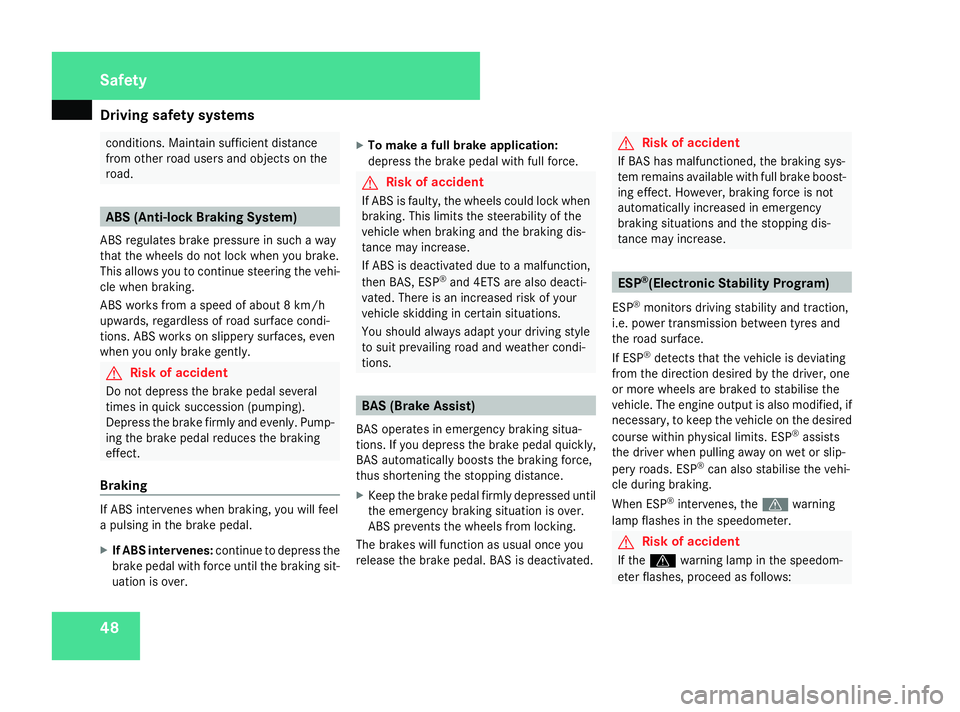
Driving safety sys
tems48 conditions. Maintain sufficient distance
from other road users and objects on the
road. ABS (Anti-lock Braking System)
ABS regulates brake pressure in such a way
that the wheels do not lock when you brake.
This allows you to continue steering the vehi-
cle when braking.
ABS works from a speed of about 8 km/h
upwards, regardless of road surface condi-
tions. ABS works on slippery surfaces, even
when you only brake gently. G
Risk of accident
Do not depress the brake pedal several
times in quick succession (pumping).
Depress the brake firmly and evenly. Pump-
ing the brake pedal reduces the braking
effect.
Braking If ABS intervenes when braking, you will feel
a pulsing in the brake pedal.
X If ABS intervenes: continue to depress the
brake pedal with force until the braking sit-
uation is over. X
To make a full brake application:
depress the brake pedal with full force. G
Risk of accident
If ABS is faulty, the wheels could lock when
braking. This limits the steerability of the
vehicle when braking and the braking dis-
tance may increase.
If ABS is deactivated due to a malfunction,
then BAS, ESP ®
and 4ETS are also deacti-
vated. There is an increased risk of your
vehicle skidding in certain situations.
You should always adapt your driving style
to suit prevailing road and weather condi-
tions. BAS (Brake Assist)
BAS operates in emergency braking situa-
tions. If you depress the brake pedal quickly,
BAS automatically boosts the braking force,
thus shortening the stopping distance.
X Keep the brake pedal firmly depressed until
the emergency braking situation is over.
ABS prevents the wheels from locking.
The brakes will function as usual once you
release the brake pedal. BAS is deactivated. G
Risk of accident
If BAS has malfunctioned, the braking sys-
tem remains available with full brake boost-
ing effect. However, braking force is not
automatically increased in emergency
braking situations and the stopping dis-
tance may increase. ESP
®
(Electronic Stability Program)
ESP ®
monitors driving stability and traction,
i.e. power transmission between tyres and
the road surface.
If ESP ®
detects that the vehicle is deviating
from the direction desired by the driver, one
or more wheels are braked to stabilise the
vehicle. The engine output is also modified, if
necessary, to keep the vehicle on the desired
course within physical limits. ESP ®
assists
the driver when pulling away on wet or slip-
pery roads. ESP ®
can also stabilise the vehi-
cle during braking.
When ESP ®
intervenes, the vwarning
lamp flashes in the speedometer. G
Risk of accident
If the v warning lamp in the speedom-
eter flashes, proceed as follows: Safety
463_AKB; 1; 8, en-GB
wobuchh
,V ersion: 2.10.6
2008-07-17T15:19:41+02:00 - Seite 48 Dateiname: 6515_4091_02_buchblock.pdf; preflight
Page 52 of 293
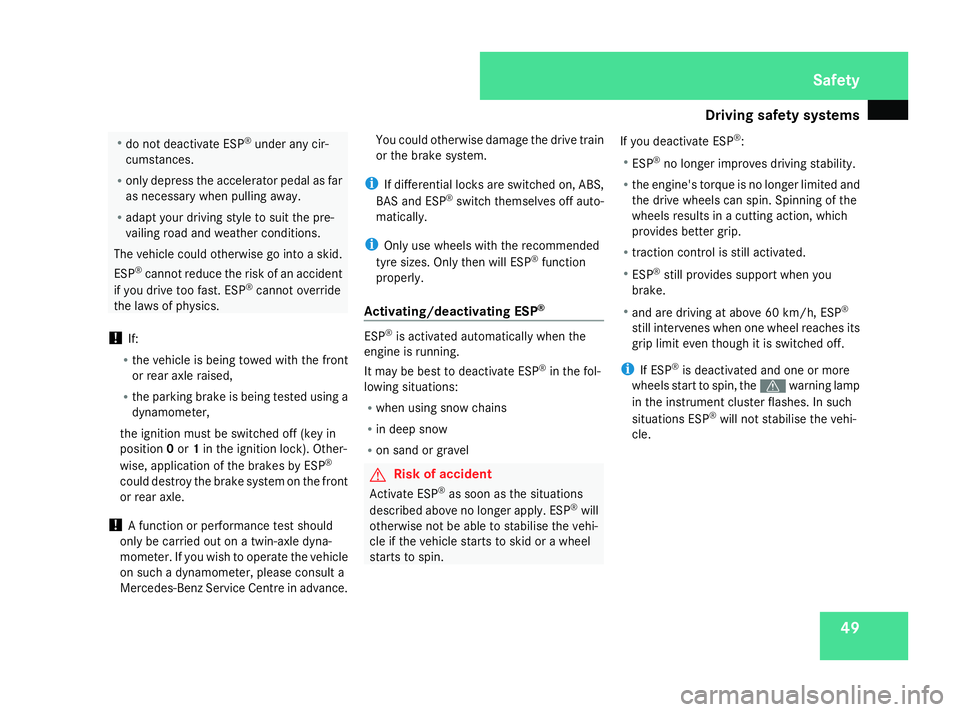
Driving safety sys
tems 49R
do not deactivate ESP ®
under any cir-
cumstances.
R only depress the accelerator pedal as far
as necessary when pulling away.
R adapt your driving style to suit the pre-
vailing road and weather conditions.
The vehicle could otherwise go into a skid.
ESP ®
cannot reduce the risk of an accident
if you drive too fast. ESP ®
cannot override
the laws of physics.
! If:
R the vehicle is being towed with the front
or rear axle raised,
R the parking brake is being tested using a
dynamometer,
the ignition must be switched off (key in
position 0or 1in the ignition lock). Other-
wise, application of the brakes by ESP ®
could destroy the brake system on the front
or rear axle.
! A function or performance test should
only be carried out on a twin-axle dyna-
mometer. If you wish to operate the vehicle
on such a dynamometer, please consult a
Mercedes-Benz Service Centre in advance. You could otherwise damage the drive train
or the brake system.
i If differential locks are switched on, ABS,
BAS and ESP ®
switch themselves off auto-
matically.
i Only use wheels with the recommended
tyre sizes. Only then will ESP ®
function
properly.
Activating/deactivating ESP ® ESP
®
is activated automatically when the
engine is running.
It may be best to deactivate ESP ®
in the fol-
lowing situations:
R when using snow chains
R in deep snow
R on sand or gravel G
Risk of accident
Activate ESP ®
as soon as the situations
described above no longer apply. ESP ®
will
otherwise not be able to stabilise the vehi-
cle if the vehicle starts to skid or a wheel
starts to spin. If you deactivate ESP
®
:
R ESP ®
no longer improves driving stability.
R the engine's torque is no longer limited and
the drive wheels can spin. Spinning of the
wheels results in a cutting action, which
provides better grip.
R traction control is still activated.
R ESP ®
still provides support when you
brake.
R and are driving at above 60 km/h, ESP ®
still intervenes when one wheel reaches its
grip limit even though it is switched off.
i If ESP ®
is deactivated and one or more
wheels start to spin, the vwarning lamp
in the instrument cluster flashes. In such
situations ESP ®
will not stabilise the vehi-
cle. Safety
463_AKB; 1; 8, en-GB
wobuchh
,V ersion: 2.10.6
2008-07-17T15:19:41+02:00 - Seite 49 ZDateiname: 6515_4091_02_buchblock.pdf; preflight
Page 53 of 293
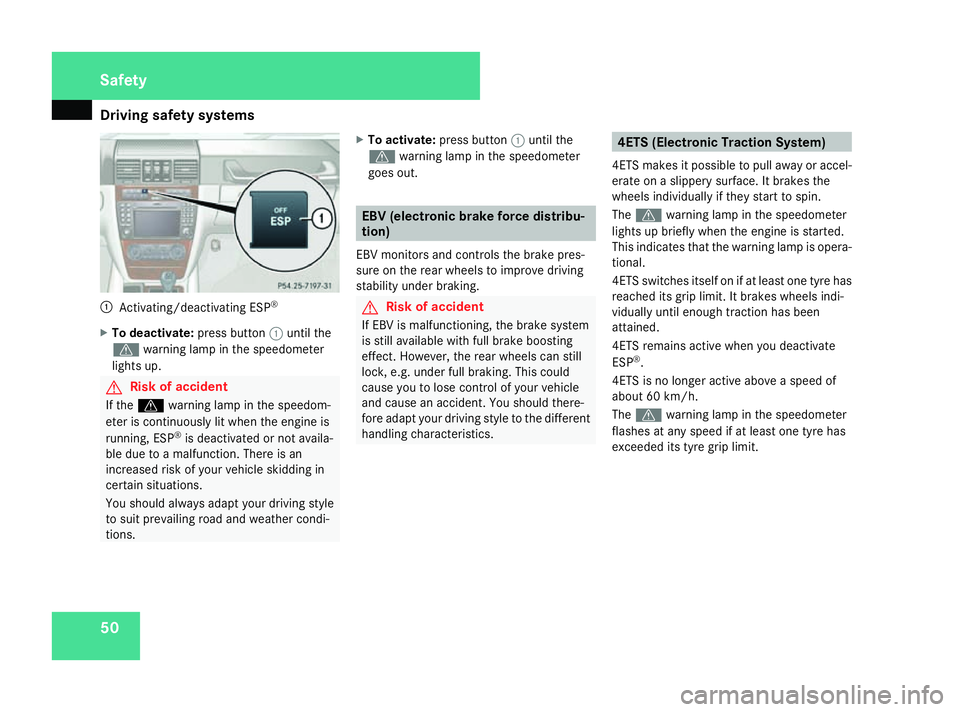
Driving safety sys
tems501
Activating/deactivating ESP ®
X To deactivate: press button1until the
v warning lamp in the speedometer
lights up. G
Risk of accident
If the v warning lamp in the speedom-
eter is continuously lit when the engine is
running, ESP ®
is deactivated or not availa-
ble due to a malfunction. There is an
increased risk of your vehicle skidding in
certain situations.
You should always adapt your driving style
to suit prevailing road and weather condi-
tions. X
To activate: press button 1until the
v warning lamp in the speedometer
goes out. EBV (electronic brake force distribu-
tion)
EBV monitors and controls the brake pres-
sure on the rear wheels to improve driving
stability under braking. G
Risk of accident
If EBV is malfunctioning, the brake system
is still available with full brake boosting
effect. However, the rear wheels can still
lock, e.g. under full braking. This could
cause you to lose control of your vehicle
and cause an accident. You should there-
fore adapt your driving style to the different
handling characteristics. 4ETS (Electronic Traction System)
4ETS makes it possible to pull away or accel-
erate on a slippery surface. It brakes the
wheels individually if they start to spin.
The v warning lamp in the speedometer
lights up briefly when the engine is started.
This indicates that the warning lamp is opera-
tional.
4ETS switches itself on if at least one tyre has
reached its grip limit. It brakes wheels indi-
vidually until enough traction has been
attained.
4ETS remains active when you deactivate
ESP ®
.
4ETS is no longer active above a speed of
about 60 km/h.
The v warning lamp in the speedometer
flashes at any speed if at least one tyre has
exceeded its tyre grip limit. Safety
463_AKB; 1; 8, en-GB
wobuchh
,V ersion: 2.10.6
2008-07-17T15:19:41+02:00 - Seite 50 Dateiname: 6515_4091_02_buchblock.pdf; preflight
Page 54 of 293
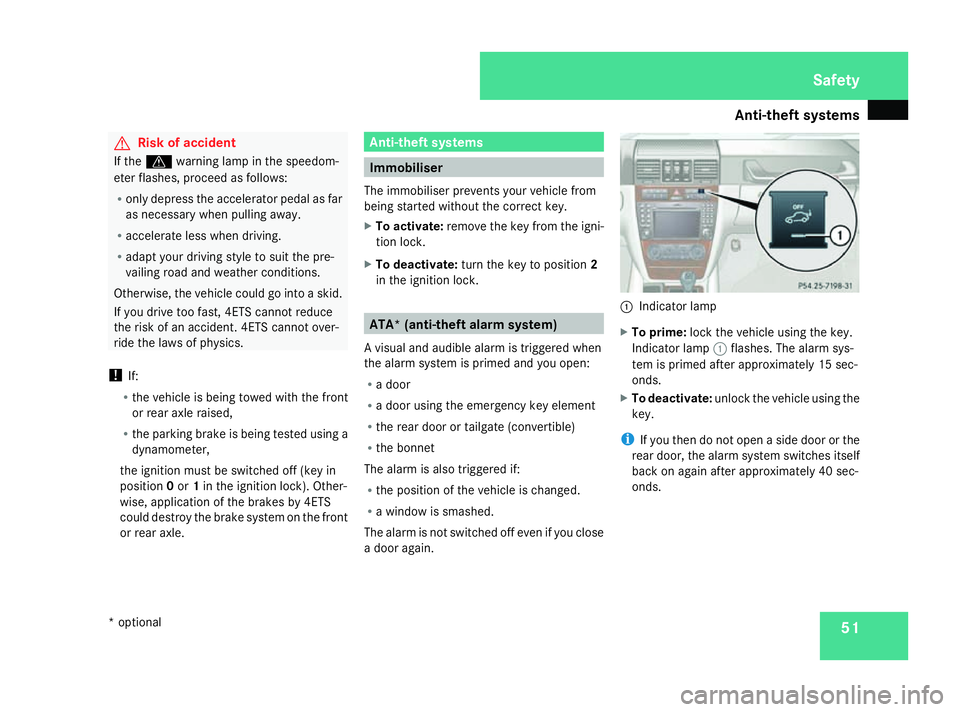
Anti-theft syste
ms 51G
Risk of accident
If the v warning lamp in the speedom-
eter flashes, proceed as follows:
R only depress the accelerator pedal as far
as necessary when pulling away.
R accelerate less when driving.
R adapt your driving style to suit the pre-
vailing road and weather conditions.
Otherwise, the vehicle could go into a skid.
If you drive too fast, 4ETS cannot reduce
the risk of an accident. 4ETS cannot over-
ride the laws of physics.
! If:
R the vehicle is being towed with the front
or rear axle raised,
R the parking brake is being tested using a
dynamometer,
the ignition must be switched off (key in
position 0or 1in the ignition lock). Other-
wise, application of the brakes by 4ETS
could destroy the brake system on the front
or rear axle. Anti-theft systems
Immobiliser
The immobiliser prevents your vehicle from
being started without the correct key.
X To activate: remove the key from the igni-
tion lock.
X To deactivate: turn the key to position 2
in the ignition lock. ATA* (anti-theft alarm system)
A visual and audible alarm is triggered when
the alarm system is primed and you open:
R a door
R a door using the emergency key element
R the rear door or tailgate (convertible)
R the bonnet
The alarm is also triggered if:
R the position of the vehicle is changed.
R a window is smashed.
The alarm is not switched off even if you close
a door again. 1
Indicator lamp
X To prime: lock the vehicle using the key.
Indicator lamp 1flashes. The alarm sys-
tem is primed after approximately 15 sec-
onds.
X To deactivate: unlock the vehicle using the
key.
i If you then do not open a side door or the
rear door, the alarm system switches itself
back on again after approximately 40 sec-
onds. Safety
* optional
463_AKB; 1; 8, en-GB
wobuchh
,V ersion: 2.10.6
2008-07-17T15:19:41+02:00 - Seite 51 ZDateiname: 6515_4091_02_buchblock.pdf; preflight
Page 55 of 293
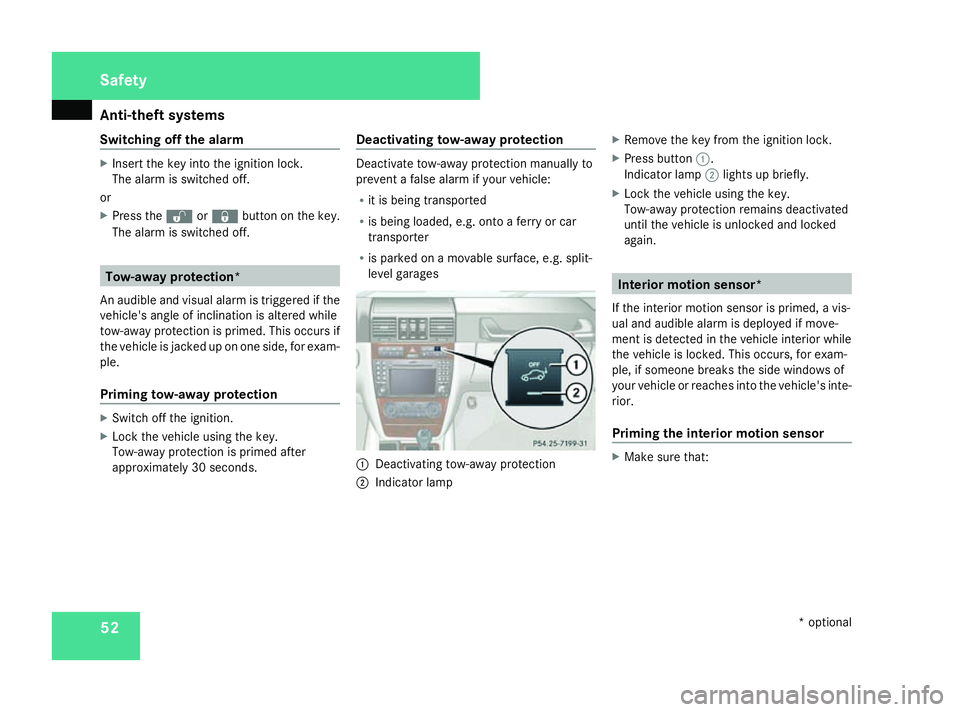
Anti-theft syste
ms52
Switching off the alarm X
Insert the key into the ignition lock.
The alarm is switched off.
or
X Press the Œor‹ button on the key.
The alarm is switched off. Tow-away protection*
An audible and visual alarm is triggered if the
vehicle's angle of inclination is altered while
tow-away protection is primed. This occurs if
the vehicle is jacked up on one side, for exam-
ple.
Priming tow-away protection X
Switch off the ignition.
X Lock the vehicle using the key.
Tow-away protection is primed after
approximately 30 seconds. Deactivating tow-away protection Deactivate tow-away protection manually to
prevent a false alarm if your vehicle:
R
it is being transported
R is being loaded, e.g. onto a ferry or car
transporter
R is parked on a movable surface, e.g. split-
level garages 1
Deactivating tow-away protection
2 Indicator lamp X
Remove the key from the ignition lock.
X Press button 1.
Indicator lamp 2lights up briefly.
X Lock the vehicle using the key.
Tow-away protection remains deactivated
until the vehicle is unlocked and locked
again. Interior motion sensor*
If the interior motion sensor is primed, a vis-
ual and audible alarm is deployed if move-
ment is detected in the vehicle interior while
the vehicle is locked. This occurs, for exam-
ple, if someone breaks the side windows of
your vehicle or reaches into the vehicle's inte-
rior.
Priming the interior motion sensor X
Make sure that: Safety
* optional
463_AKB; 1; 8, en-GB
wobuchh
,V ersion: 2.10.6
2008-07-17T15:19:41+02:00 - Seite 52 Dateiname: 6515_4091_02_buchblock.pdf; preflight
Page 56 of 293
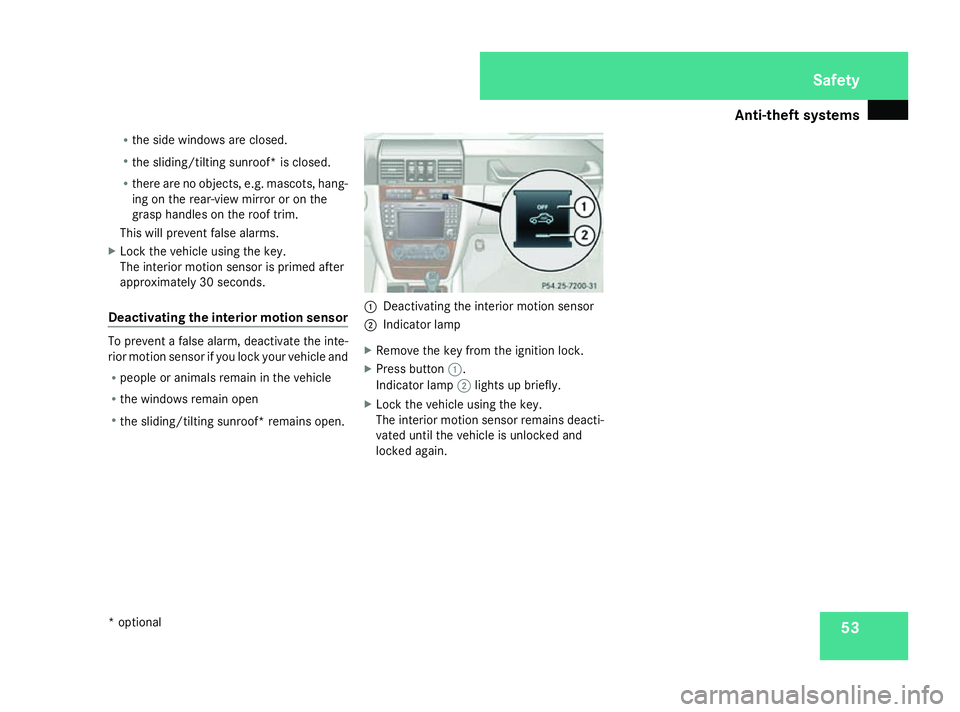
Anti-theft syste
ms 53
R
the side windows are closed.
R the sliding/tilting sunroof* is closed.
R there are no objects, e.g. mascots, hang-
ing on the rear-view mirror or on the
grasp handles on the roof trim.
This will prevent false alarms.
X Lock the vehicle using the key.
The interior motion sensor is primed after
approximately 30 seconds.
Deactivating the interior motion sensor To prevent a false alarm, deactivate the inte-
rior motion sensor if you lock your vehicle and
R
people or animals remain in the vehicle
R the windows remain open
R the sliding/tilting sunroof* remains open. 1
Deactivating the interior motion sensor
2 Indicator lamp
X Remove the key from the ignition lock.
X Press button 1.
Indicator lamp 2lights up briefly.
X Lock the vehicle using the key.
The interior motion sensor remains deacti-
vated until the vehicle is unlocked and
locked again. Safety
* optional
463_AKB; 1; 8, en-GB
wobuchh
,V ersion: 2.10.6
2008-07-17T15:19:41+02:00 - Seite 53 ZDateiname: 6515_4091_02_buchblock.pdf; preflight
Page 57 of 293
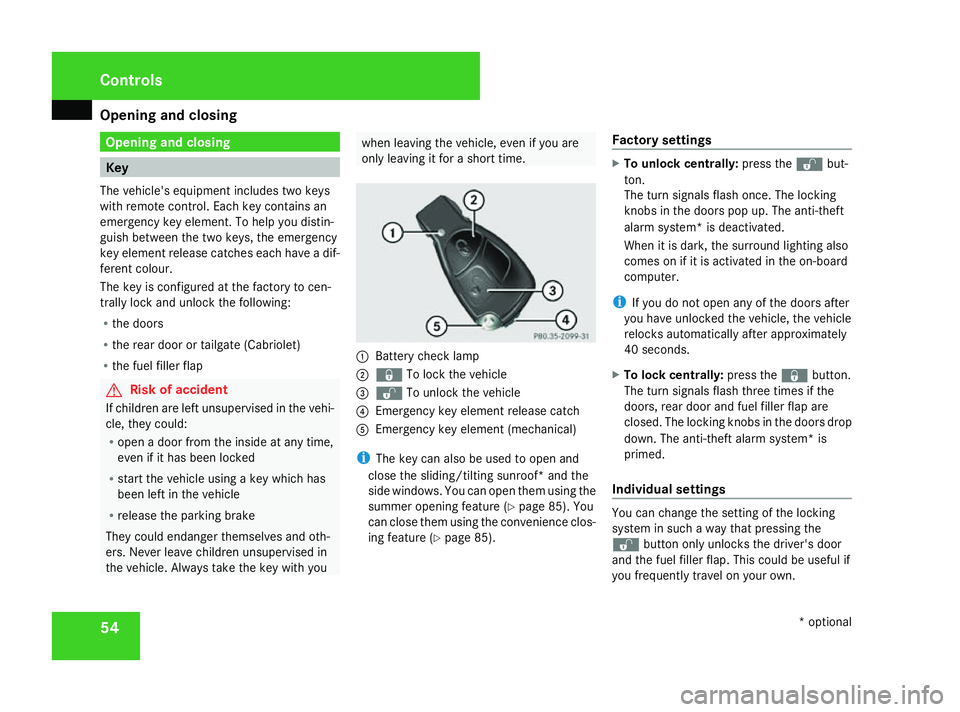
Opening and closing
54 Opening and closing
Key
The vehicle's equipment includes two keys
with remote control. Each key contains an
emergency key element. To help you distin-
guish between the two keys, the emergency
key element release catches each have a dif-
ferent colour.
The key is configured at the factory to cen-
trally lock and unlock the following:
R the doors
R the rear door or tailgate (Cabriolet)
R the fuel filler flap G
Risk of accident
If children are left unsupervised in the vehi-
cle, they could:
R open a door from the inside at any time,
even if it has been locked
R start the vehicle using a key which has
been left in the vehicle
R release the parking brake
They could endanger themselves and oth-
ers. Never leave children unsupervised in
the vehicle. Always take the key with you when leaving the vehicle, even if you are
only leaving it for a short time. 1
Battery check lamp
2 j To lock the vehicle
3 k To unlock the vehicle
4 Emergency key element release catch
5 Emergency key element (mechanical)
i The key can also be used to open and
close the sliding/tilting sunroof* and the
side windows. You can open them using the
summer opening feature (Y page 85). You
can close them using the convenience clos-
ing feature (Y page 85). Factory settings X
To unlock centrally: press thekbut-
ton.
The turn signals flash once. The locking
knobs in the doors pop up. The anti-theft
alarm system* is deactivated.
When it is dark, the surround lighting also
comes on if it is activated in the on-board
computer.
i If you do not open any of the doors after
you have unlocked the vehicle, the vehicle
relocks automatically after approximately
40 seconds.
X To lock centrally: press thejbutton.
The turn signals flash three times if the
doors, rear door and fuel filler flap are
closed. The locking knobs in the doors drop
down. The anti-theft alarm system* is
primed.
Individual settings You can change the setting of the locking
system in such a way that pressing the
k button only unlocks the driver's door
and the fuel filler flap. This could be useful if
you frequently travel on your own. Controls
* optional
463_AKB; 1; 8, en-GB
wobuchh,
Version: 2.10.6
2008-07-17T15:19:41+02:00 - Seite 54 Dateiname: 6515_4091_02_buchblock.pdf; preflight
Page 58 of 293
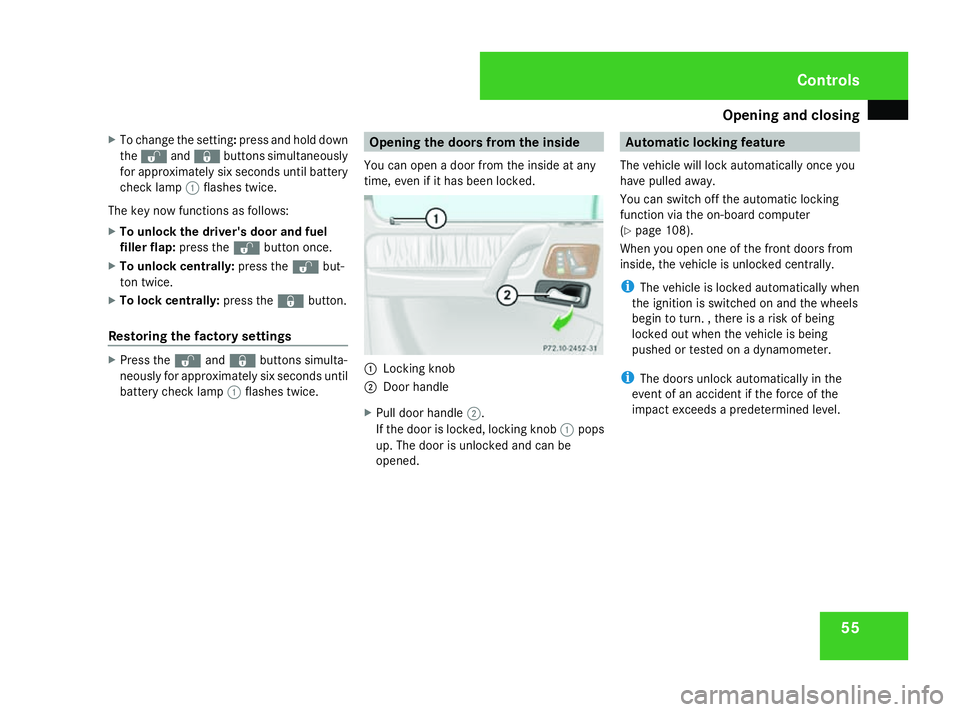
Opening and closing
55
X
To change the setting: press and hold down
the k andj buttons simultaneously
for approximately six seconds until battery
check lamp 1flashes twice.
The key now functions as follows:
X To unlock the driver's door and fuel
filler flap: press thekbutton once.
X To unlock centrally: press thekbut-
ton twice.
X To lock centrally: press thejbutton.
Restoring the factory settings X
Press the kandj buttons simulta-
neously for approximately six seconds until
battery check lamp 1flashes twice. Opening the doors from the inside
You can open a door from the inside at any
time, even if it has been locked. 1
Locking knob
2 Door handle
X Pull door handle 2.
If the door is locked, locking knob 1pops
up. The door is unlocked and can be
opened. Automatic locking feature
The vehicle will lock automatically once you
have pulled away.
You can switch off the automatic locking
function via the on-board computer
(Y page 108).
When you open one of the front doors from
inside, the vehicle is unlocked centrally.
i The vehicle is locked automatically when
the ignition is switched on and the wheels
begin to turn. , there is a risk of being
locked out when the vehicle is being
pushed or tested on a dynamometer.
i The doors unlock automatically in the
event of an accident if the force of the
impact exceeds a predetermined level. Controls
463_AKB; 1; 8, en-GB
wobuchh,
Version: 2.10.6 2008-07-17T15:19:41+02:00 - Seite 55 ZDateiname: 6515_4091_02_buchblock.pdf; preflight
Page 59 of 293
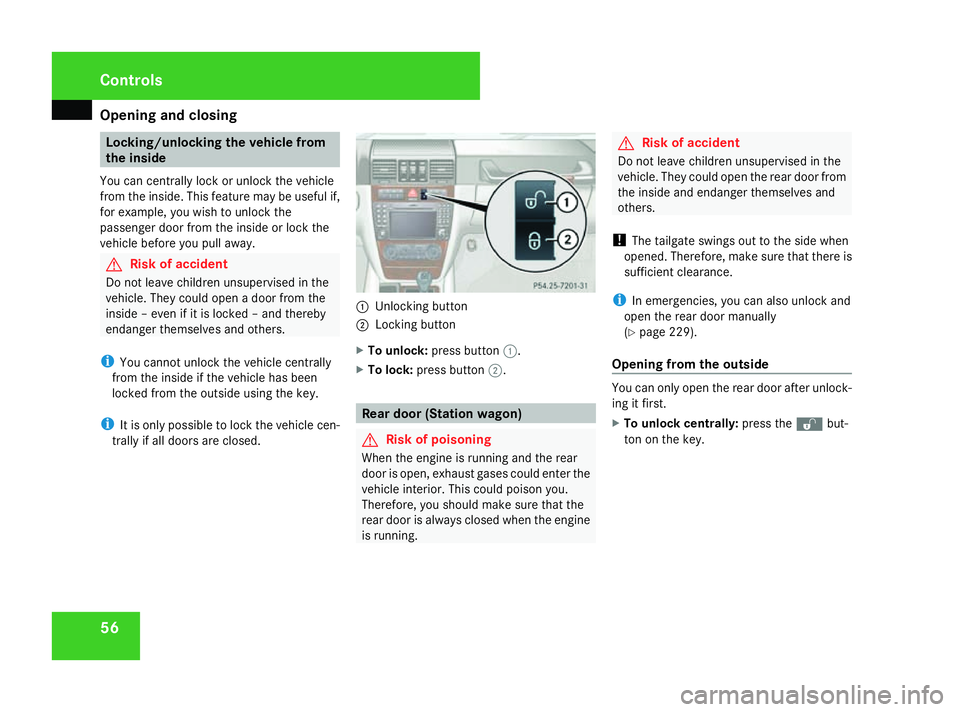
Opening and closing
56 Locking/unlocking the vehicle from
the inside
You can centrally lock or unlock the vehicle
from the inside. This feature may be useful if,
for example, you wish to unlock the
passenger door from the inside or lock the
vehicle before you pull away. G
Risk of accident
Do not leave children unsupervised in the
vehicle. They could open a door from the
inside – even if it is locked – and thereby
endanger themselves and others.
i You cannot unlock the vehicle centrally
from the inside if the vehicle has been
locked from the outside using the key.
i It is only possible to lock the vehicle cen-
trally if all doors are closed. 1
Unlocking button
2 Locking button
X To unlock: press button 1.
X To lock: press button 2. Rear door (Station wagon)
G
Risk of poisoning
When the engine is running and the rear
door is open, exhaust gases could enter the
vehicle interior. This could poison you.
Therefore, you should make sure that the
rear door is always closed when the engine
is running. G
Risk of accident
Do not leave children unsupervised in the
vehicle. They could open the rear door from
the inside and endanger themselves and
others.
! The tailgate swings out to the side when
opened. Therefore, make sure that there is
sufficient clearance.
i In emergencies, you can also unlock and
open the rear door manually
(Y page 229).
Opening from the outside You can only open the rear door after unlock-
ing it first.
X
To unlock centrally: press thekbut-
ton on the key. Controls
463_AKB; 1; 8, en-GB
wobuchh,
Version: 2.10.6 2008-07-17T15:19:41+02:00 - Seite 56Dateiname: 6515_4091_02_buchblock.pdf; preflight
Page 60 of 293
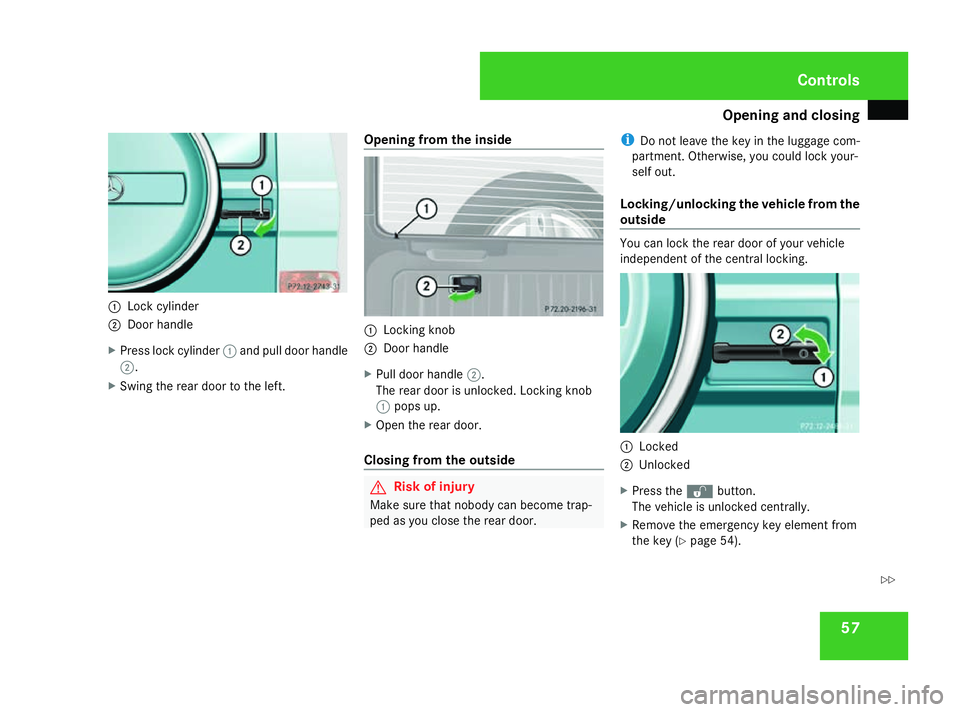
Opening and closing
571
Lock cylinder
2 Door handle
X Press lock cylinder 1and pull door handle
2.
X Swing the rear door to the left. Opening from the inside 1
Locking knob
2 Door handle
X Pull door handle 2.
The rear door is unlocked. Locking knob
1 pops up.
X Open the rear door.
Closing from the outside G
Risk of injury
Make sure that nobody can become trap-
ped as you close the rear door. i
Do not leave the key in the luggage com-
partment. Otherwise, you could lock your-
self out.
Locking/unlocking the vehicle from the
outside You can lock the rear door of your vehicle
independent of the central locking.
1
Locked
2 Unlocked
X Press the kbutton.
The vehicle is unlocked centrally.
X Remove the emergency key element from
the key (Y page 54). Controls
463_AKB; 1; 8, en-GB
wobuchh,
Version: 2.10.6 2008-07-17T15:19:41+02:00 - Seite 57 ZDateiname: 6515_4091_02_buchblock.pdf; preflight